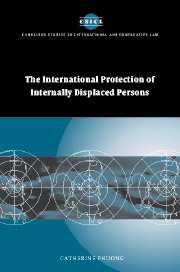Book contents
- Frontmatter
- Contents
- Acknowledgments
- Table of cases
- Table of treaties and other international documents
- List of abbreviations
- Introduction
- 1 Internally displaced persons and refugees: conceptual differences and similarities
- 2 The legal protection of internally displaced persons
- 3 The institutional framework of protection for the internally displaced
- 4 Protection strategies for the internally displaced
- 5 Case study: internal displacement in Bosnia and Herzegovina
- 6 Reconceiving sovereignty and intervention
- Conclusions
- Annex 1: The Guiding Principles on Internal Displacement
- Bibliography
- Index
- CAMBRIDGE STUDIES IN INTERNATIONAL AND COMPARATIVE LAW
5 - Case study: internal displacement in Bosnia and Herzegovina
Published online by Cambridge University Press: 17 July 2009
- Frontmatter
- Contents
- Acknowledgments
- Table of cases
- Table of treaties and other international documents
- List of abbreviations
- Introduction
- 1 Internally displaced persons and refugees: conceptual differences and similarities
- 2 The legal protection of internally displaced persons
- 3 The institutional framework of protection for the internally displaced
- 4 Protection strategies for the internally displaced
- 5 Case study: internal displacement in Bosnia and Herzegovina
- 6 Reconceiving sovereignty and intervention
- Conclusions
- Annex 1: The Guiding Principles on Internal Displacement
- Bibliography
- Index
- CAMBRIDGE STUDIES IN INTERNATIONAL AND COMPARATIVE LAW
Summary
The present chapter provides, based on field and other research, a case study on internal displacement in Bosnia and Herzegovina which examines how the issues addressed in previous chapters were dealt with in the specific context of Bosnia and Herzegovina. It illustrates the limits of field activities pursued in isolation from a human rights framework and goals. It also reviews initiatives undertaken to promote the return of refugees and internally displaced persons to their homes and to reverse ethnic cleansing in order to examine the human rights implications of these return strategies.
The situation in Bosnia and Herzegovina has been chosen as the case study for the following reasons. First, it is the only situation of internal displacement where virtually all the protection strategies discussed in the previous chapter were applied. Attempts to provide international protection to the internally displaced have taken place in the prevention phase, during displacement and upon return, whereas, in other crises, international efforts have not focused on each phase of displacement. The case study thus serves as an illustration of how protection strategies were implemented in a concrete case and the limits of such strategies. Secondly, Bosnia and Herzegovina is also one of the rare situations in which most UN human rights and humanitarian bodies have been involved, and therefore provides an opportunity to analyse coordination mechanisms. Peacekeeping forces and humanitarian organisations were present in the country, as well as a small human rights monitoring team.
- Type
- Chapter
- Information
- The International Protection of Internally Displaced Persons , pp. 155 - 207Publisher: Cambridge University PressPrint publication year: 2005



